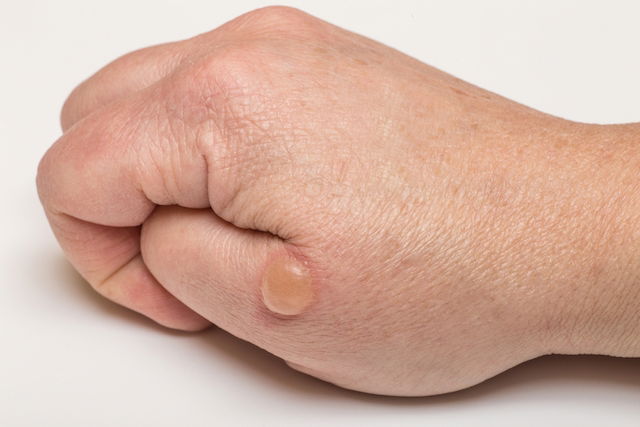A second degree burn is a serious type of burn that affects the middle layers of the skin. It is associated with symptoms such as intense pain, redness and a blister on the skin, which should be protected from rupturing to prevent exposure to bacteria and infection.
This degree of burn can be caused by chemical, thermal or electrical agents, and is very painful as it can damage nerve endings, hair follicles and skin glands.
In most cases, second degree burns can be treated at home with cold water and skin ointments. However, burns that are intensely painful or are larger than 1 inch in diameter should be urgently assessed.

What it looks like
A second degree burn will typically present with the following characteristics:
- A blister at the site
- Intense pain
- Redness or darkening of the skin
- Moist and shiny skin
- Detachment of skin layers
- Very painful wound at the site if the blister bursts.
Second-degree burns commonly occur due to accidents at home, like coming in contact with boiling water, oil, or fire, or touching hot surfaces, like a stove.
Healing time
The healing time for a second-degree burn is usually between 2 and 3 weeks, but can vary depending on the size of the burn and the area of the body affected.
After healing, a second-degree burn can leave a lighter stain, or even a scar if the burn is deeper.
How to treat
To treat a second degree burn at home, you should:
- Remove contact with the heat source immediately. If your clothes are on fire, roll on the floor until the flame is ignited. Do not run or cover yourself with blankets if your clothing is on fire. If the clothing becomes stuck to the skin, you should not try to remove it at home, as this could worsen skin wounds. Proceed to a hospital for removal by a medical professional.
- Place the burned skin under cool, running water (at a gentle pressure) for at least 20 minutes or until the skin stops burning. This helps to reduce pain and swelling, and can prevent the burn from getting worse. Do not apply very cold water or ice to the area, as this can aggravate the skin lesion.
- Soak a sterile compress or clean cloth in saline solution or cold water and cover the affected area. This helps to reduce the pain during the first few hours.
After removing the wet dressing, you can apply a burn ointment. This helps with pain management and helps promote wound healing.
What not to do
If a blister forms, do not try to rupture it. Rupturing a blister increases the risk of infection, which can delay healing and may require further treatment with antibiotics. If necessary, the blister should only be drained in the hospital by a doctor under sterile conditions.
In addition, alcohol, sugar, coffee grounds, butter, oil, toothpaste or any other substance should not be applied to the burn. It is important not to touch the area or pick at any scabs. If other substances are melted on the skin, do not attempt to remove them at home.
Minor second-degree burns can be treated with burn-specific ointment and then covered with a gauze dressing.
Major burns usually require hospital admission for days to weeks, until the tissues are well healed and risk for infection and dehydration is eliminated.
Extensive second and third degree burns will usually require prolonged hospitalization with medication, IV fluids, a targeted diet and physiotherapy.
When to go to the emergency room
You should proceed to an emergency room if the burn is larger than the palm of one hand or affects multiple areas of the body.
You should also go to the emergency room if you have a burn on the head, face, neck, palms of the hands, soles of the feet, groin, thighs, knees, wrists or buttocks, as these are areas with a higher risk of infection. You should also seek urgent assessment if the burn has been caused by electricity or chemicals.
Babies, children and older adults with any type of burn should be assessed by a doctor immediately.






























